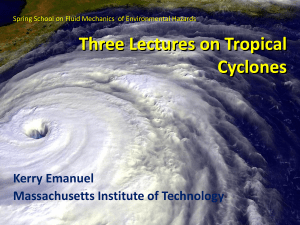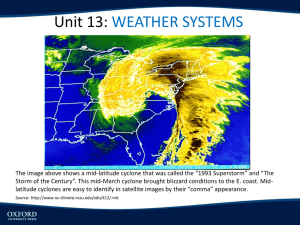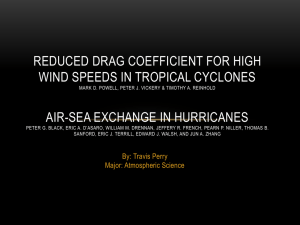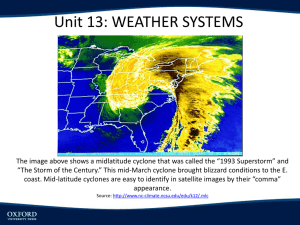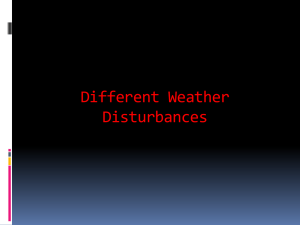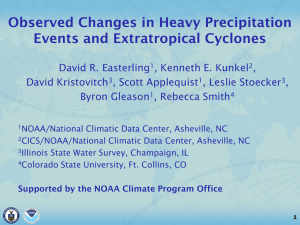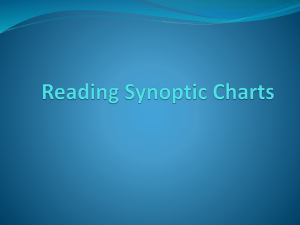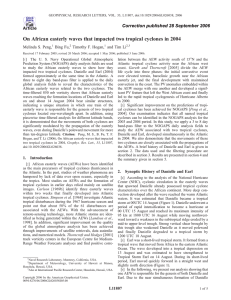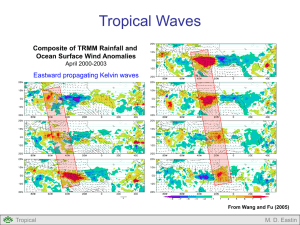Tropical Revolving Storms
advertisement
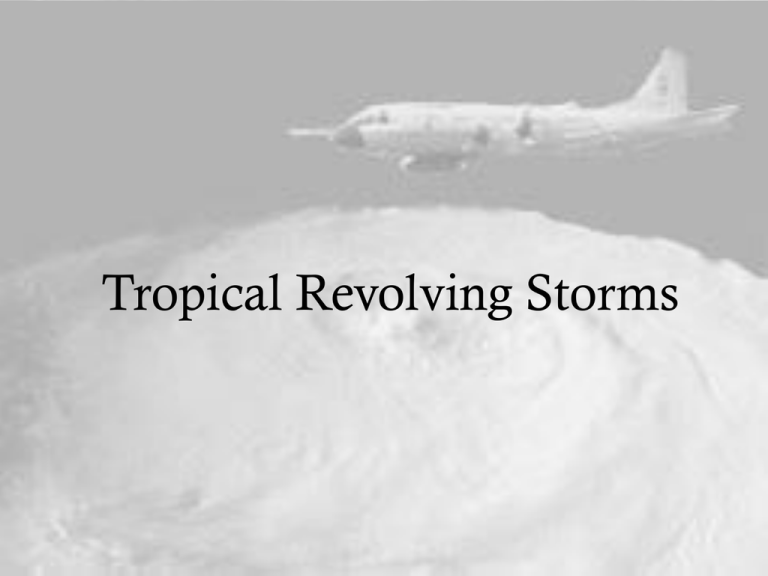
Tropical Revolving Storms Tropical Cyclogenesis • Warm ocean waters - at least 26.5°C throughout a depth of 50m • Unstable/moist atmosphere - rapid cooling with height • Moist layers near the mid-troposhere • At least 500km from the Equator with sufficient Coriolis force to provide geostrophic rotation Tropical Cyclogenesis • Pre-existing near-surface disturbance with sufficient vorticity & convergence • Low levels of vertical windshear between the surface and upper troposphere Tropical Cyclones • Low pressure systems deriving energy primarily from evaporation from a warm sea • Associated with high winds, lowered pressure and convective clouds concentrated around the centre • A tropical cyclone is the generic term for a nonfrontal synoptic scale low-pressure system over tropical or sub- tropical waters with organised convection (i.e. thunderstorm activity) and definite cyclonic surface wind circulation • The storms tend to affect certain areas: – They occur mainly on the western edge of oceans after the winds have had a long sea track and the air has acquired a large amount of moisture. – They occur in the summer hemisphere in areas where the ITCZ has reached a latitude of 10°N or S or greater and where there is sufficient geostrophic force to produce cyclonic rotation. – They do not originate over land. • The terms "hurricane" and "typhoon" are regionally specific names for a strong "tropical cyclone". • Tropical cyclones with maximum sustained surface winds of less than 17 m/s (34 kt) are called "tropical depressions". • Typical tropical cyclones have an “eye” in the centre. - The "eye" = roughly circular area of comparatively light winds and fair weather, approx. 30-60km dia. - Calm winds at the axis of rotation, but strong winds may extend well into the eye. - Little or no precipitation and sometimes blue sky or stars can be seen. - The eye is composed of air that is slowly sinking. • Once the tropical cyclone reaches sustained winds of at least 17 m/s (34 kt) they are typically called a "tropical storm" and assigned a name. • If winds reach 33 m/s (64 kt), then they are called: • "hurricane" (the North Atlantic Ocean, the Northeast Pacific Ocean east of the dateline, or the South Pacific Ocean east of 160E); • "typhoon" (the Northwest Pacific Ocean west of the dateline); • "severe tropical cyclone" (the Southwest Pacific Ocean west of 160E or Southeast Indian Ocean east of 90E); • "severe cyclonic storm" (the North Indian Ocean); • a "tropical cyclone" (the Southwest Indian Ocean near Madagascar) • In West Africa the squally trough is known locally as a tornado but is not to be confused with a tornado as described in Chapter 16. TRS Names From 1979 individual storms were allocated alternate male and female first names alphabetically starting with A at the beginning of each storm season (e.g. Alfred, Barbara, Charles, etc.) TRS Names • In the Northwest Pacific basin, Asian names are selected by members of the WMO Typhoon Committee. • N. Indian Ocean storms are allocated numbers Weather associated with a TRS • Very strong to extreme wind conditions • All hazards associated with TS activity • Severe pressure disturbances making pressure instruments unreliable • Torrential rain • Calm eye with subsidence Weather associated with a TRS • Anticylonic outflow above the storm with subsidence and fine weather around the edges giving a deceptive calm before the storm • Increasing sea swell as the storm approaches TRS Tracks and Seasons HURRICANES (July - Oct) CYCLONES (May - Oct) TYPHOONS (May - Nov) CYCLONES (Dec - April) CYCLONES (Nov - May) Frequency of Tropical Cyclones • Tropical Storm/Cyclone averages for the various areas are: – N.W.Pacific (South China Sea) about 25 times per season, – Atlantic about 9 -10 times per season – N.E. Pacific (Coast of Central America) about 16 -17 times per season Frequency of Tropical Cyclones – N. Indian (Gulf of Arabia and Bay of Bengal); 5 - 6 times per season. – S.W. Indian Ocean (Madagascar) about 10 - 11 times per season. – S.E. Indian Ocean (W. Australia) about 7 times per season. – S.W.Pacific (E. Australia) 9 times per season. – Global Average 84 - 85 per annum. Easterly wave Easterly Waves • The equatorial trough is a permanent series of thermal lows in a more or less continuous belt around the earth. • On both sides of the equatorial low pressure belt, troughs sometimes extend out towards the sub-tropical high pressure belts. • These troughs, known as easterly waves, move westwards under the influence of the easterly upper winds. Easterly Waves • The Easterly waves are extremely important phenomena since they are related to the formation of hurricanes in the north Atlantic. But not all easterly waves results in a violent tropical revolving storm. Easterly Waves • Easterly waves are most frequent during late summer when surface water temperature is highest. They occur mainly in the western parts of large ocean basins between 5° and 20° latitude. Easterly Waves • Easterly waves are usually very apparent over West Africa where they can be seen from their formation zone over Sudan/Ethiopia and westwards. Easterly Waves Easterly Waves • Clusters are often formed east of the Philippines and north of New Guinea where the water is the warmest, at about 30°C. • This is also the area where most tropical cyclones are generated in the world. • The clusters formed in this area move westward towards Borneo but they seldom show the typical characteristics of an Atlantic Easterly wave. Storm Tracks • What determines the movement of tropical cyclones? – Generally tropical cyclones tend to follow the circulation around the subtropical highs existing over the oceans.
